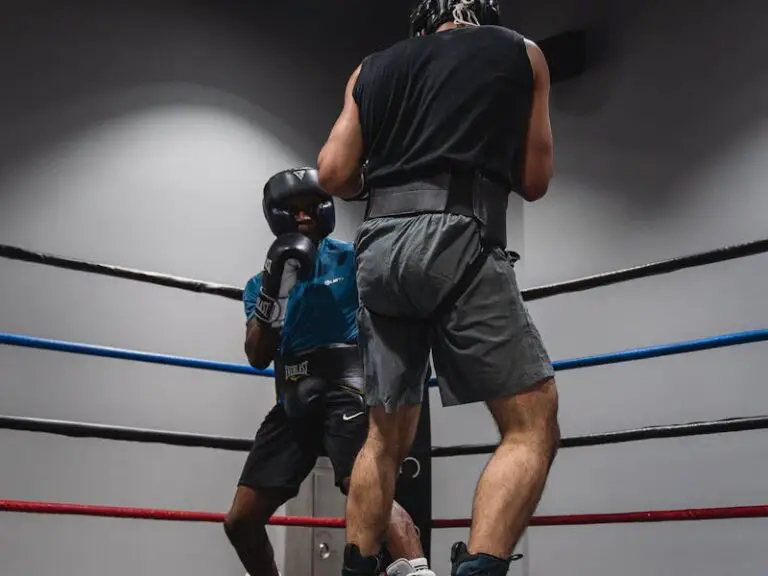Boxing might be popular and well-established worldwide, but, it is also a leader in combat sports injuries. It is practised by millions of people worldwide, and many of them wonder, why boxing is dangerous. Yes, it is a full-contact striking sport, but what makes it more dangerous than the others?
To better understand this, we have decided to do a detailed analysis, look at the recent studies related to repeated head strikes, common injuries, and most importantly, what are the exact reasons that make boxing dangerous, and how to prevent them.
How Dangerous is Boxing
Boxing is a full-contact combat sport, and as such, it carries a high risk of injuries. According to studies, pro boxers suffer between 17.1 and 23.6 injuries per 100 fights or 13.3 injuries per year.
According to another research, boxing accounts for a substantial number of injuries, with head injuries being the most prevalent. A study found that approximately 84% of all boxing injuries involve the head and neck.
Furthermore, the severity of these injuries should not be underestimated. Head and neck injuries can lead to concussions and even long-term brain damage. This was confirmed by the Association of Neurological Surgeons research according to which 90% of boxers suffer concussions at some point in their careers. Most of them are more than a few.
Furthermore, one Canadian study performed in 2016 compared data from post-fight medical examinations in both boxing and MMA. They found that head trauma in boxing is higher, as well as the concussion rate, due to the higher frequency of head strikes in boxing.
These, long-term effects of boxing can include chronic traumatic encephalopathy (CTE), which is a degenerative brain disease commonly found in athletes exposed to repetitive head trauma.
Apart from concussions, other severe injuries such as facial fractures, broken ribs, internal bleeding, and other injuries are quite common.
Why Boxing Is So Dangerous?
The key reason lies in the concept itself as boxing revolves around throwing repeated punches to the head with full power over an extended period. Pro boxers dedicate their lives to developing skills as well as strength and endurance to land vicious blows and knock the opponent out.
To better understand why boxing is dangerous, let’s look at some of the other reasons.
Highest Head Striking Rate
On average, pro boxers attempt close to 800 head strikes per 12-round match with the ones in the heavier division less and the ones in the lower divisions more. Or around 65 strikes per one boxing round.
Next, each boxer lands with an average accuracy between 30% and 40% meaning that, if the match goes to distance, boxers absorb between 300–350 punches, with the most landing to the head since this is a prioritized target. That’s a lot.
Of course, not all of these shots land with full power. But don’t forget, the danger of head trauma in boxing lies in repeated strikes and cumulative damage.
Power and Damage emphasis
Although boxing is a highly technical sport, the main objective is clear. Each boxer steps into the ring to land clean and powerful shots, hurt the opponent, cause injuries, and in the best-case scenario, knock them out.
Knockouts, in particular, are important because this increases their value and popularity. But it also contributes to the neurological consequences of boxing.
In the gym, they work on developing athleticism, strength, and skills needed to execute these strikes with perfection. They throw thousands of punches per session, visualize their opponent, and dedicate their lives to those knockouts because that’s their job and what brings the food to the table.
Busy Fighting Schedule
All boxers first need to compete on the amateur scene before going pro. At this level, they often compete every 2 weeks, multiple times a day representing their gyms in leagues and other tournaments. Some pro boxers, like Genard Golovking, have hundreds of recorded amateur matches BEFORE they enter pro competition.
Even when they go pro, boxers would compete up to 4 or 5 times a year while building their way up. Once they become established contenders, they would fight around 2–3 times per year. But still, it is not uncommon to see boxers compete even more than that and retire with 100+ fights which adds to the long-term effects of boxing.
Frequent sparring
Sparring is the best method for learning how to apply techniques in real combat and developing skills such as timing, feeling for distance, and training your instincts. But, it also makes boxing dangerous.
While at the learning stage, boxers usually spar 2 or 3 times a week. On the other side, pro boxers have between 50 and 100 rounds of hard sparring during their training camps. On top of that, they usually spar against other good boxers and contenders so they are putting a lot of stress on their bodies.
Heavy Gloves — Greater Force
The impact of gloves on boxing safety should not be underestimated. Boxing uses heavier gloves to protect the hands and prevent these injuries.
But at the same time, heavier gloves also mean that you can generate bigger force in a punch, which then results in increased concussion rates. According to the British Medical Association, full-padded gloves do not reduce the risk of brain injuries.
A 10-second count Increases the Danger
Although not a decisive factor, the infamous 10-second count rule contributes to the high rate of injuries, especially concussions. Once a boxer receives a hard blow, usually to the head, and goes down, they get 10 seconds to get up and show they are recovered and ready to continue.
The danger is that in a lot of cases, these boxers hit the floor concussed or badly hurt. Thanks to their incredible toughness, they would work their way up and be conscious enough to get the green light from the referee before getting blasted once again.
Most Common Boxing Injuries
The most common injuries in boxing are also among the worst ones. Since 90% of injuries are related to the head and neck, injuries such as concussions facial lacerations and fractures are quite common.
- Concussions — caused by either repeated or single power punches to the head. This can lead to brain trauma, or be lethal in worst cases.
- Skin lacerations — like cuts and bruises occur frequently due to the repetitive blows to the head and face. Studies have shown that boxers experience a high number of these types of injuries during their careers.
- Contusions — are common in most sports and may cause swelling or pain.
- Spains — including muscle and ligament injuries happen when the muscles are overloaded, overused, stretched, and fatigued.
- Fractures and dislocations — are also prevalent in boxing, typically affecting the hands, wrists, and facial bones. These injuries often require medical intervention and can have long-lasting effects on a boxer’s ability to continue fighting and their overall well-being.
How Many Boxers Have Died?
Approximately 1,900 boxers have lost their lives as a result of injuries sustained in boxing matches from 1884 to 2021.
The deadliest year on record was 1953, witnessing the unfortunate deaths of 22 boxers due to injuries sustained in the ring. Although more recent and precise data might not be available, studies, such as one from 2009, suggest an approximate rate of 0.13 deaths per 1,000 participants annually.
On average, it is reported that around 13 boxers succumb to injuries each year, according to “The Manuel Velazquez Boxing Fatality Collection.” However, it’s important to note that these statistics may vary based on different sources and evolving safety measures in the sport.
How to Prevent Injuries in Boxing?
When it comes to boxing injury prevention strategies, most are related to training because there is not much one can do when it comes to competition.
This includes wearing proper equipment, reducing sparring rounds, reducing the intensity of sparring, working on conditioning, and many other reasons listed below.
- Proper Warm-Up — Cold muscles are more prone to injury. Doing dynamic stretches gets the blood going through the muscles, and warms them up for a more intense activity.
- Focus on Technique (be patient) — Incorrect form can lead to strains, sprains, and overuse injuries. Just a light punch at the wrong angle can cause pain so prioritize proper technique to reduce the risks.
- Rest, a lot of rest — not enough recovery time increases the risk of muscle overuse, chronic inflammation, and fatigue. Be smart and plan your rest days well.
- Protective gear — invest in high-quality protective gear. And, always wear it whenever you are sparring, even if it is light contact.
- Manage sparring sessions — avoid getting into gym wars, and sparring hard all the time. Instead, take a methodical approach with your coach. You don’t need to spar hard all the time or spar all the time at all.
Is Boxing More Dangerous Than MMA?
Though MMA visually looks like a more violent sport, Boxing is actually more dangerous because of the greater concussion rate and head and neck injuries. On average, boxers absorb far more repeated head blows which is what ultimately makes it more dangerous.
MMA has a high injury rate. However, the majority of these injuries are lacerations and sprains with the concussion rate being lower. On top of that, cage fighters absorb fewer head blows because fighters spend a lot of time grappling, wrestling, and fighting on the ground using submissions.
On average, MMA fighters spend around 5 minutes per 15-minute match grappling according to studies. And even on the feet, a big portion of landed strikes are kicks to the legs or body. So overall, they absorb much, much less head blows.
But the boxing vs MMA debate is a complex one and the only fair answer is that both sports involve similar risks.
Is Boxing Worth It With All The Risks?
While boxing undoubtedly offers adrenaline, discipline, and a sense of accomplishment to its practitioners, the alarming frequency and severity of injuries, particularly to the head and neck, is alarming to any beginner.
The sport’s emphasis on powerful head strikes, frequent competitions, and rigorous training regimens contribute to a high likelihood of long-term physical and neurological damage, including concussions and chronic traumatic encephalopathy (CTE).
The rewards of boxing, like personal growth, athleticism, and fame, might seem appealing, but they need to be balanced against the serious risks. Boxers must think carefully about their values, priorities, and personal situation before deciding if boxing is right for them.


